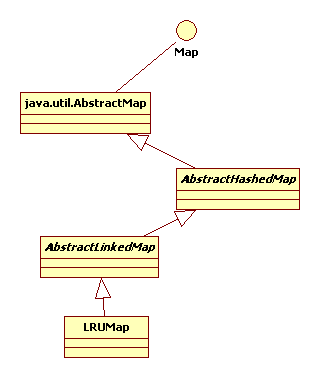本文通过对Apache Commons Collections 项目中LRUMap这个集合类的源代码进行详细解读,为帮助大家更好的了解这个集合类的实现原理以及使用如何该集合类。
首先介绍一下LRU算法. LRU是由Least Recently Used的首字母组成,表示最近最少使用的含义,一般使用在对象淘汰算法上。也是比较常见的一种淘汰算法。
LRUMap 则是实现的LRP算法的Map集合类,它继承于AbstractLinkedMap 抽象类。LRUMap的使用说明如下:
LRUMap的初始化时需要指定最大集合元素个数,新增的元素个数大于允许的最大集合个数时,则会执行LRU淘汰算法。所有的元素在LRUMap中会根据最近使用情况进行排序。最近使用的会放在元素的最前面(LRUMap是通过链表来存储元素内容). 所以LRUMap进行淘汰时只需要删除链表最后一个即可(即header.after所指的元素对象)
那么那些操作会影响元素的使用情况:
1. put 当新增加一个集合元素对象,则表示该对象是最近被访问的
2. get 操作会把当前访问的元素对象作为最近被访问的,会被移到链接表头
注:当执行containsKey和containsValue操作时,不会影响元素的访问情况。
LRUMap也是非线程安全。在多线程下使用可通过 Collections.synchronizedMap(Map)操作来保证线程安全。
LRUMap的一个简单使用示例:
public static void main(String[] args) {
Map lru = new LRUMap(3);
lru.put("1", 1);
lru.put("2", 2);
lru.get("1");
lru.put("3", 3);
lru.put("4", 4);
System.out.println(lru);
}
上面的示例,当增加”3”和“4”值时,会淘汰最近最少使用的”2”, 最后输出的结果为:
{1=1, 3=3, 4=4}
下面根据LRUMap的源码来解读一下LRUMap的实现原理
整体类图
真实类图:
LRUMap类的关键代码说明如下:
1. get操作:
moveToMRU方法代码如下
protected void moveToMRU(final LinkEntry<K, V> entry) {
if (entry.after != header) {
modCount++;
// remove
if(entry.before == null) {
thrownew IllegalStateException("Entry.before is null." +
" Please check that your keys are immutable, and that you have used synchronization properly." +
" If so, then please report this to dev@commons.apache.org as a bug.");
}
entry.before.after = entry.after;
entry.after.before = entry.before;
// add first
entry.after = header;
entry.before = header.before;
header.before.after = entry;
header.before = entry;
} elseif (entry == header) {
thrownew IllegalStateException("Can't move header to MRU" +
" (please report this to dev@commons.apache.org)");
}
}
2. put新增操作
由于继承的AbstractLinkedMap,所以put操作会调用addMapping 方法,完整代码如下:
@Override
protectedvoid addMapping(finalinthashIndex, finalinthashCode, final K key, final V value) {
if (isFull()) {
LinkEntry<K, V> reuse = header.after;
booleanremoveLRUEntry = false;
if (scanUntilRemovable) {
while (reuse != header && reuse != null) {
if (removeLRU(reuse)) {
removeLRUEntry = true;
break;
}
reuse = reuse.after;
}
if (reuse == null) {
thrownew IllegalStateException(
"Entry.after=null, header.after" + header.after + " header.before" + header.before +
" key=" + key + " value=" + value + " size=" + size + " maxSize=" + maxSize +
" Please check that your keys are immutable, and that you have used synchronization properly." +
" If so, then please report this to dev@commons.apache.org as a bug.");
}
} else {
removeLRUEntry = removeLRU(reuse);
}
if (removeLRUEntry) {
if (reuse == null) {
thrownew IllegalStateException(
"reuse=null, header.after=" + header.after + " header.before" + header.before +
" key=" + key + " value=" + value + " size=" + size + " maxSize=" + maxSize +
" Please check that your keys are immutable, and that you have used synchronization properly." +
" If so, then please report this to dev@commons.apache.org as a bug.");
}
reuseMapping(reuse, hashIndex, hashCode, key, value);
} else {
super.addMapping(hashIndex, hashCode, key, value);
}
} else {
super.addMapping(hashIndex, hashCode, key, value);
}
}
当集合的个数超过指定的最大个数时,会调用 reuseMapping函数,把要删除的对象的key和value更新为新加入的值,并再次加入到链接表中,并重新排定次序。
reuseMapping函数代码如下:
protectedvoid reuseMapping(final LinkEntry<K, V> entry, finalinthashIndex, finalinthashCode,final K key, final V value) {
// find the entry before the entry specified in the hash table
// remember that the parameters (except the first) refer to the new entry,
// not the old one
try {
finalintremoveIndex = hashIndex(entry.hashCode, data.length);
final HashEntry<K, V>[] tmp = data; // may protect against some sync issues
HashEntry<K, V> loop = tmp[removeIndex];
HashEntry<K, V> previous = null;
while (loop != entry && loop != null) {
previous = loop;
loop = loop.next;
}
if (loop == null) {
thrownew IllegalStateException(
"Entry.next=null, data[removeIndex]=" + data[removeIndex] + " previous=" + previous +
" key=" + key + " value=" + value + " size=" + size + " maxSize=" + maxSize +
" Please check that your keys are immutable, and that you have used synchronization properly." +
" If so, then please report this to dev@commons.apache.org as a bug.");
}
// reuse the entry
modCount++;
removeEntry(entry, removeIndex, previous);
reuseEntry(entry, hashIndex, hashCode, key, value);
addEntry(entry, hashIndex);
} catch (final NullPointerException ex) {
thrownew IllegalStateException(
"NPE, entry=" + entry + " entryIsHeader=" + (entry==header) +
" key=" + key + " value=" + value + " size=" + size + " maxSize=" + maxSize +
" Please check that your keys are immutable, and that you have used synchronization properly." +
" If so, then please report this to dev@commons.apache.org as a bug.");
}
}
上面的代码中:
removeEntry 方法是删除最近最少使用的节点在链接中的引用
reuseEntry方法则把该节点的key和value赋新加入的节点的key和value值
addEntry 方法则把该节点加入到链接表,并保障相关的链接顺序
/**
* Adds an entry into this map, maintaining insertion order.
* <p>
* This implementation adds the entry to the data storage table and
* to the end of the linked list.
*
* @param entry the entry to add
* @param hashIndex the index into the data array to store at
*/
@Override
protectedvoid addEntry(final HashEntry<K, V> entry, finalinthashIndex) {
final LinkEntry<K, V> link = (LinkEntry<K, V>) entry;
link.after = header;
link.before = header.before;
header.before.after = link;
header.before = link;
data[hashIndex] = link;
}
LRUMap的主要源码实现就解读到这里,实现思路还是比较好理解的。
LRUMap的使用场景会比较多,例如可以很方便的帮我们实现基于内存的 LRU 缓存服务实现。
转载于:http://www.blogjava.net/xmatthew/archive/2012/06/28/380150.html——大牛(xmatthew)







相关推荐
LRU算法实现LRU算法实现LRU算法实现LRU算法实现LRU算法实现
(1) LRU:内存管理的一种页面置换算法,对于在内存中但又不用的数据块(内存块)叫做LRU,操作系统会根据哪些数据属于LRU而将其移出内存而腾出空间来加载另外的数据。 (2) LRU算法:LRU是Least Recently Used的...
这是自己在os课实验上自己写的一个页面替换算法cpp文件,里面包含了FIFO与LRU置换算法的实现程序。简单正确,同时加上了代码注释,一目了然。
LRU算法的java实现
近期最少使用算法
该资源是Java实现LRU算法的相关代码,将页面序号和进程分配的模块数,运行出具体的变化过程,真实可靠,可实现。
详细介绍了四种LRU算法,并有代码实现。
使用c语言是实现的LRU算法,带测试用例,供大家学习参考使用
操作系统中的一个算法 C++实现的,Lru算法
C语言写的lru算法,验证过了,可以用。大概还是不错的
计算机系统结构实验虚拟存储。用lru和fifo 实现页面置换,计算命中率
用C语言实现的OPT和LRU算法,下载后直接用VC++6.0打开即可编译运行。亲测可用。
基于python的LRU算法设计与实现
lru算法,供大家参考欢迎下载使用,并提出意见
用C语言的堆栈实现LRU算法,简单、易懂
LRU页面置换算法实现 一请求分页存储系统,进程P共有5页,访问串为3,2,1,0,3,2,4,3,2,1,0,4,试采用LRU算法和LFU算法分析,当分配页面数为3时,发生的缺页中断次数
1.资源包含LRU算法整个项目,可直接在vs2019上运行项目,如果版本不对可选择把项目中cpp文件复制到自己的vs中运行 2.LRU 算法的设计原则是:如果一个数据在最近一段时间没有被访问到,那么在将来它被访问的可能性也...
简单数组实现LRU算法
/**** 用于LRU入栈 *****/ void PUSH1(seqstack *s,datatype x,int nc_size){ // s->pop++; while(s->pop){ s->pop++; if(s->data[s->pop]==x){ for(int i=s->pop;i;i++){ s->data[i]=s->data[i+1]; } } } ...
使用LRU算法实现页面置换算法。LRU算法基于一种假设,长期不使用的数据,在未来的使用性也不大。因此,当数据占用内存达到一定的阙值时,我们要移除最近最少使用的数据。LRU算法中,使用了一种有趣的数据结构,叫做...